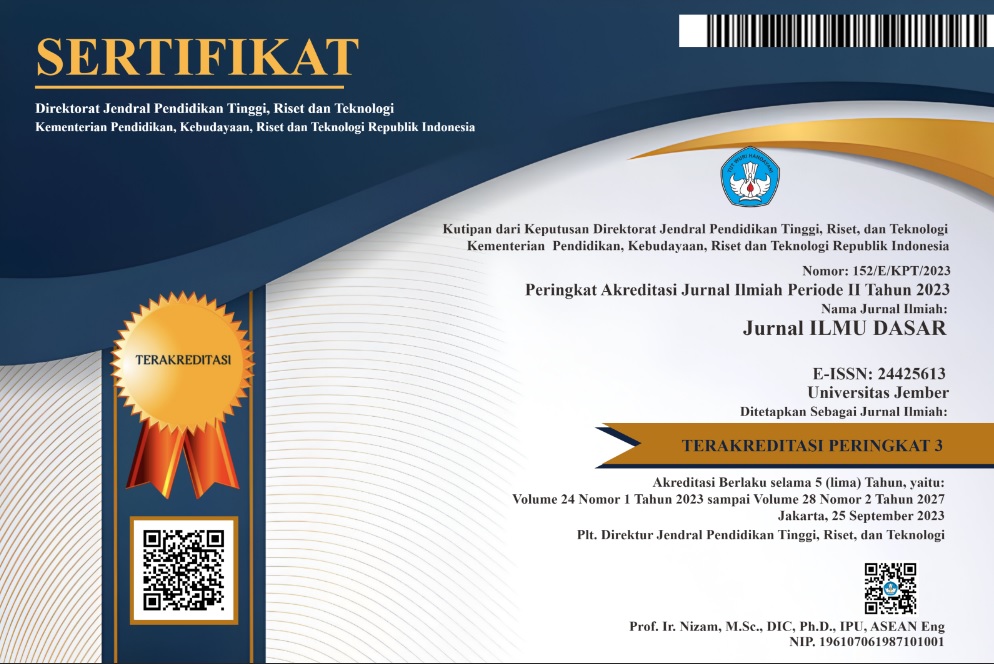The Effect of Taro Tuber Starch (Colocasia esculenta (L.) schott) Addition to Characteristic of Biodegradable Plastic with PVA Polymer and Calcium Carbonate (CaCO3) Filler
DOI:
https://doi.org/10.19184/jid.v24i1.33409Keywords:
Biodegradable Plastic, Taro Starch, polyvinyl alcohol (PVA)Abstract
The preparation of biodegradable plastics based on polyvinyl alcohol (PVA)-taro starch as an alternative to synthetic plastics has been conducted. The aim of this research was to identify the effect of taro starch composition on the production of biodegradable plastic and their characteristics in an aquatic environment. The solution casting method was used to produce biodegradable plastic. PVA was dissolved in hot distilled water, and taro starch (0; 0.5; 1.5; 2.5; and 3.5 g) was dissolved in another chamber filled with distilled water, glycerol and citric acid. Both solutions were mixed together and CaCO3 was then added. The mixture was casted on acrylic plates while biodegradable plastic without starch was used as a control. Characteristic of Biodegradable plastic and it’s properties were examined by Fourier Transform Infra Red (FTIR), water uptake, and moisture absorption test. While the biodegrability of the sample were tested in river water media in the laboratory. The results showed that the wave number at 1698-1712 cm-1, indicating that the cross-linking between PVA and the starch occured. Water uptake and moisture absorption tests showed that all of the biodegradable plastic varieties produced were hydrophilic. The biodegradation test showed that the largest degree of decomposition was reached by the PVA-starch 3.5 g variety which was 80.33%. Thus, the more starch on biodegradable plastic, the more biodegradation achieved.
Downloads
References
Coniwanti P, Laila L & Alfira MR. 2014. Pembuatan Film Plastik Biodegredabel dari Pati Jagung Dengan Penambahan Kitosan Dan Pemplastis Gliserol. Jurnal Teknik Kimia. 20(4): 22-30.
Erni N, Kadirman K & Fadilah R. 2018. Pengaruh Suhu dan Lama Pengeringan Terhadap Sifat Kimia Danorganoleptik Tepung Umbi Talas (Colocasia esculenta). Jurnal Pendidikan Teknologi Pertanian. 1(1): 95.
Gürler N, Paşa S, Erdoğan Ö & Cevik O. 2021. Physicochemical Properties for Food Packaging and Toxicity Behaviors Against Healthy Cells of Environmentally Friendly Biocompatible Starch/Citric Acid/Polyvinyl Alcohol Biocomposite Films. Starch/Staerke, (September).
Hasanah YR & Haryanto. 2017. The effect of addition calcium carbonate (CaCO3) and clay on mechanical and biodegradable plastic properties of tapioca waste. Techno. 18(2): 96-107.
Jambeck J, Geyer R, Wilcox C, Siegler TR, Perryman M, Andrady A & Law KL. 2015. the Ocean : the Ocean : Marine Pollution, 347(6223): 768-. Retrieved from https://science.sciencemag.org/CONTENT/347/6223/768.abstract.
Kawijia, Windi A & Sri L. 2017. Studi Karakteristik Pati Singkong Utuh Berbasis Edible Film Dengan Modifikasi Cross-Lingking Asam Sitrat. Jurnal Teknologi Pertanian. 18(2): 143-152.
Kirk Othmer, O. (2021). Encyclopedia of chemical technology. WATCHER.
Marfu’ah Z. 2015. Pengaruh Variasi Komposisi Low Density Polyethylene (LDPE) dan Pati Bonggol Pisang untuk Pembuatan Plastik Biodegradable, [Thesis] Universitas Islam Negeri Maulana Malik Ibrahim. 1-91.
MB S & Illing I. 2017. Uji FTIR Bioplastik Dari Limbah Ampas Sagu Dengan Penambahan Variasi Konsentrasi Gelatin. Jurnal Dinamika. 08(2): 1-13.
Muchtadi D & Sugiyono TR. 1992. Petunjuk Laboratorium Ilmu Pengetahuan Bahan Pangan. Jakarta: PAU Institut Pertanian Bogor dan Depdiknas.
Munthoub DI & Rahman WAWA. 2011. Tensile and Water Absorption Properties Of Biodegradable Composites Derived From Cassava Skin/Poly Vinyl Alcohol With Glycerol as Plasticizer. Sains Malaysiana. 40(7): 713-718.
Nofiandi D, Ningsih W & Putri ASL. 2016. Pembuatan dan Karakterisasi Edible Film dari Poliblend Pati Sukun-Polivinil Alkohol dengan Propilenglikol sebagai Plasticizer. Jurnal Katalisator. 1(2): 1-12.
Nugroho FG, Nizardo NM & Saepudin E. 2020. Synthesis of Citric Acid Crosslinked PVA/tapioca Starch Bioplastic Reinforced With Grafted Cellulose. AIP Conference Proceedings, 2242(June).
Nuriyah L, Saroja G & Rohmad J. 2019. The Effect of Calcium Carbonate Addition to Mechanical Properties of Bioplastic Made from Cassava Starch with Glycerol as Plasticizer. IOP Conference Series: Materials Science and Engineering. 546(4): 6-11.
Pamela VY, Syarief R, Iriani ES & Suyatma NE. 2016. Stearat Untuk Kemasan Multilayer. Jurnal Penelitian Pascapanen Pertanian. 13(2): 63-73.
Purwaningrum P. 2016. Upaya Mengurangi Timbulan Sampah Plastik Di Lingkungan. Indonesian Journal of Urban and Environmental Technology. 8(2): 141.
Putra HP & Yuriandala Y. 2010. Studi Pemanfaatan Sampah Plastik Menjadi Produk dan Jasa Kreatif. Jurnal Sains & Teknologi Lingkungan. 2(1): 21-31.
Sumarni W & Susatyo B. 2013. Sintesis dan Karakterisasi Edible Film Kitosan Termodifikasi PVA dan Sorbitol. Indonesian Journal of Chemical Science. 2(1): 1-6.
Udjiana SS, Hadiantoro S, Syarwani M & Suharti PH. 2019. Pembuatan dan Karakterisasi Plastik Biodegradable dari Umbi Talas (Xanthosoma sagittifolium) dengan Penambahan Filler Kitosan dan Kalsium Silikat. Jurnal Teknik Kimia Dan Lingkungan. 3(1): 10.
Wahidah N. 2017. Kinetika Kimia Glukosa dari Pati Umbi Talas (Colocasia esculenta L. Schott) menggunakan Katalisator Enzim α-amilase dan Glukoamilase. Universitas Islam Negeri Alauddin Makassar. 1-94.
Wibowo AT & Andaka G. 2019. Pengaruh Penambahan Gliserin Dan Kecepatan Pengadukan Terhadap Kuat Tarik, Kemuluran, Biodegradasi Pada Proses Pembuatan Plastik Biodegradable Dari Limbah Kulit Singkong. Jurnal Inovasi Proses. 4(1): 8-13.
Widyaningsih S, Kartika D & Nurhayati YT. 2012. Pengaruh Penambahan Sorbitol dan Kalsium Karbonat Terhadap Karakteristik dan Sifat Biodegradasi Film dari Pati Kulit Pisang. Molekul. 7(1): 69-81.








